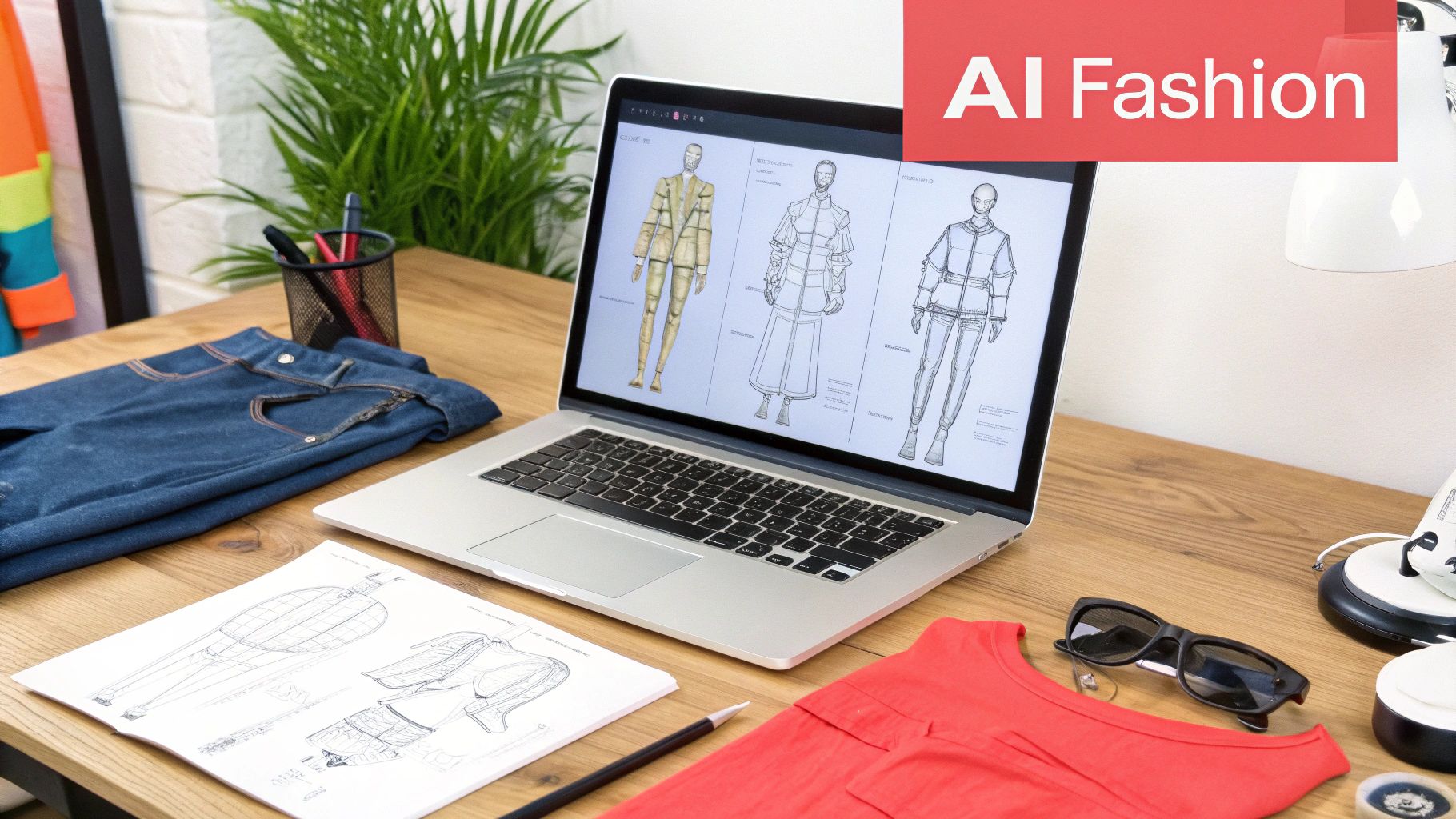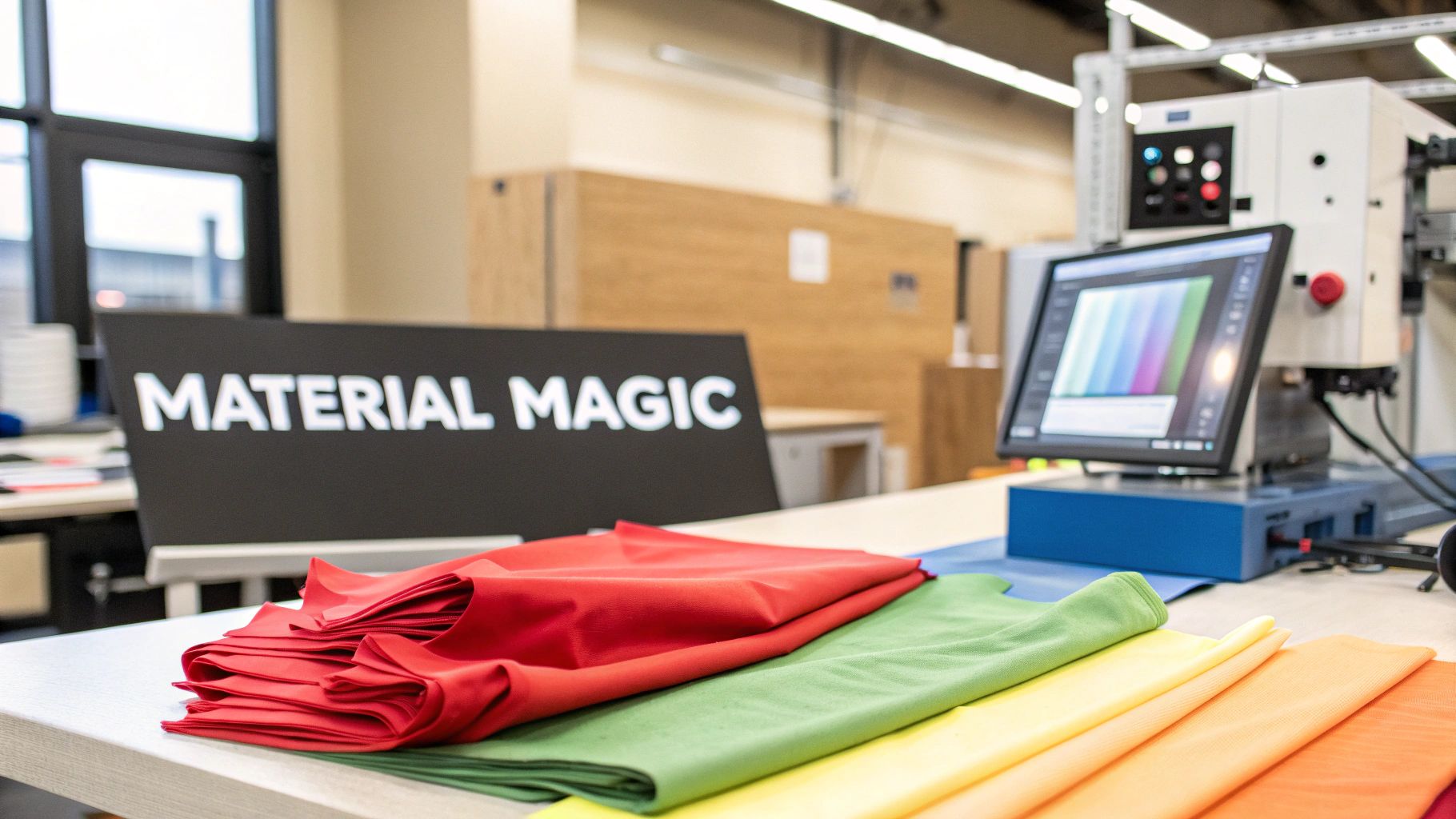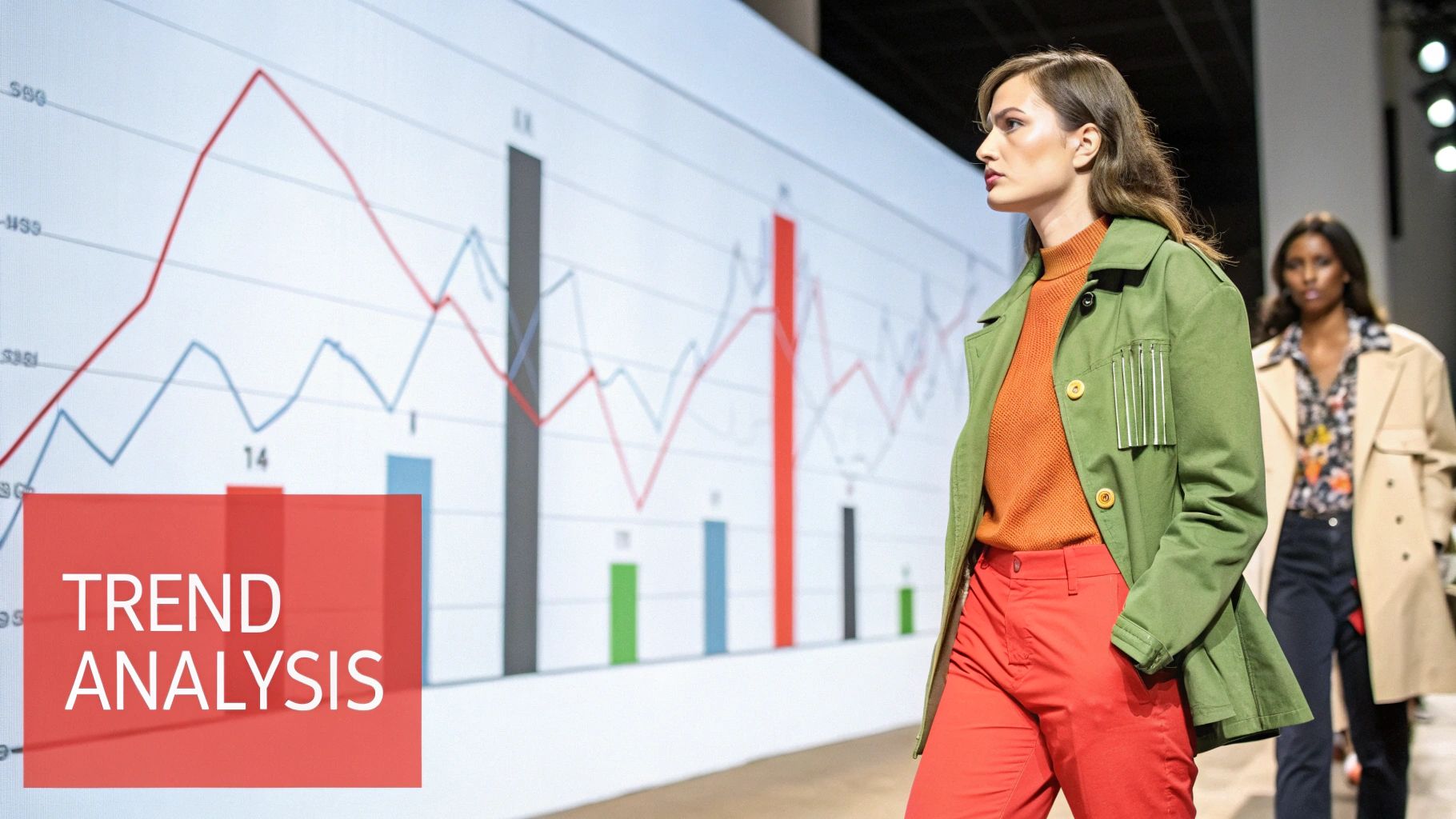The AI Fashion Revolution: Inside Today's Design Landscape

The fashion industry has always relied on human creativity. But now, Artificial Intelligence (AI) is changing the game. This technology is transforming how fashion is designed, made, and experienced. From large fashion houses to independent studios, everyone is exploring the potential of AI.
AI's Expanding Role in the Design Studio
AI is becoming an essential tool throughout the design process. Think of AI as a design assistant. It can analyze huge amounts of data to identify upcoming trends and predict what customers want. This helps designers make smarter choices about colors, shapes, and fabrics. AI tools are also making time-consuming tasks like sketching and pattern making much faster.
Market Projections and Adoption Timelines
The AI clothing design market is booming. Two key factors are driving this growth: the demand for personalized fashion and the need for greater efficiency. The global Generative AI in Fashion Market is expected to grow significantly. It's projected to jump from USD 96.5 million in 2023 to about USD 2,230.4 million by 2032. That's a CAGR of 36.9% between 2024 and 2033. While only 28% of fashion executives used generative AI in 2023, a whopping 73% plan to prioritize it in 2024. This shows a growing awareness of AI's potential in the fashion industry. For more statistics, check out this link: Generative AI in Fashion Market Statistics
Empowering Creativity, Not Replacing It
Many people worry that AI will replace human designers. But that's not the case. AI is actually a tool that enhances creativity. It helps designers explore more ideas, experiment with new styles, and push creative boundaries. By taking over repetitive tasks, AI frees up designers to focus on the artistic aspects that require human intuition. This collaboration between humans and AI is essential for the future of fashion. It leads to truly innovative designs that resonate with today's consumers. The future of fashion is a partnership, blending human creativity with the power of AI.
Transforming The Design Process: AI Tools In Action

Artificial intelligence is rapidly changing the fashion design world. It's no longer a thing of the future, but a powerful tool designers are using today. This section explores how AI is actively reshaping the design process, from the initial spark of an idea to the finished garment. We'll look at practical applications that are already impacting designers' daily work.
Streamlining The Design Workflow With AI
AI tools offer exciting new possibilities for design, allowing for faster iteration, broader exploration of options, and more efficient realization of creative visions. This translates to significant time savings, optimized resource allocation, and potentially increased profits.
-
Sketching and Concept Development: AI tools are revolutionizing the early stages of design. Designers can now input basic sketches and watch them transform into polished digital renderings. Experimenting with different silhouettes and details becomes effortless, and generating variations on initial ideas is remarkably quick.
-
Pattern Development and Grading: AI algorithms can automate the often complex processes of pattern creation and grading. This significantly reduces manual work and ensures greater accuracy, freeing designers to focus on the creative aspects of pattern cutting rather than tedious technicalities.
-
Textile and Material Selection: Finding the right fabric can be a time-consuming process. AI can now assist in identifying suitable textiles based on desired characteristics like drape, texture, and sustainability. This streamlines material selection, introduces designers to innovative new materials, and supports eco-conscious design choices.
-
Color Palette Creation and Visualization: AI algorithms can generate harmonious color palettes based on current trends, target demographics, or even specific images. Designers can instantly visualize these palettes on their designs, effortlessly exploring various color combinations to achieve the perfect aesthetic.
Integrating AI Into Your Design Process
Integrating AI into design isn't about replacing human creativity; it's about enhancing it. The transition, however, requires a strategic approach. Understanding the realistic timelines, potential challenges, and successful implementation strategies is crucial.
Successfully incorporating AI into design workflows requires careful planning. Begin by assessing your current processes and pinpointing areas where AI can make the biggest difference. Start small, with manageable projects, to gain experience and build confidence.
For teams adopting AI clothing design, prioritizing training and development is essential. Equip your team with the skills and knowledge to effectively utilize these powerful new tools. It's also important to address any concerns about job displacement. Emphasize that AI is a collaborative partner, not a replacement, freeing designers to focus on higher-level creative work. You might be interested in: How to master…
Let's look at a comparison of a few popular AI design tools:
AI Design Tools Comparison
A comparison of popular AI clothing design tools based on features, user experience, and performance metrics.
| Tool Name | Primary Function | Learning Curve | Price Range | Best For |
|---|---|---|---|---|
| Cala | End-to-end fashion design, from concept to production | Moderate | Varies based on usage | Brands and independent designers seeking a comprehensive solution |
| Khroma | AI-powered color palette generation | Easy | Free | Designers looking for color inspiration and palette creation |
| Designhill AI Logo Maker | Logo design using AI | Easy | Free – Paid options for higher resolution | Businesses and individuals needing quick and easy logo creation |
This table highlights the diverse range of AI tools available, catering to different needs and skill levels within the fashion industry. Choosing the right tool depends on your specific design requirements and budget.
The broader AI in Fashion Market is experiencing remarkable growth. Projections indicate the market will reach USD 170.62 billion by 2037, up from USD 2.19 billion in 2024, with a CAGR of around 39.8%. This growth is largely driven by the increasing use of AI in online shopping platforms and the rising demand for AI-driven fashion trends. Major brands like Zara and H&M are already using AI to analyze data from sources like fashion blogs and social media to create new designs. Explore this topic further: AI in Fashion Market Growth. This upward trajectory underscores the growing integration of AI across the fashion industry.
The Double-Edged Sword: AI Design Benefits and Challenges

AI is making a big impact on fashion design. It's opening up exciting new avenues for creativity while also presenting some hurdles. This section takes a balanced look at both the pros and cons of using AI in the design process, exploring how leading brands are using its strengths and addressing its limitations.
The Benefits of AI in Clothing Design
AI brings several key advantages to the fashion table:
-
Enhanced Efficiency: AI can automate those tedious tasks like pattern creation and grading, freeing up designers to focus on the creative side of things. This significantly speeds up the entire design process.
-
Sustainability Initiatives: AI can help with material selection, encouraging the use of eco-friendly fabrics. It can also optimize production to minimize waste and energy use.
-
Personalization Capabilities: AI can analyze consumer data to get a better understanding of individual preferences. This lets designers create personalized clothing and styles tailored to specific needs.
-
Creative Exploration: AI can help designers explore a much wider range of design options, generating new ideas and pushing creative boundaries. This can result in truly unique and innovative collections.
The Challenges of AI in Clothing Design
While AI offers many advantages, there are also challenges to address:
-
Originality Concerns: There's a worry that AI-generated designs might lack originality and create a sea of sameness. Maintaining a unique brand identity in the age of AI requires careful planning.
-
Technical Barriers: Bringing in AI tools can mean investing in new software, hardware, and training. These technical hurdles can be difficult for some businesses to overcome.
-
The Human Element: Even with AI automating many tasks, certain design elements still need that human touch. The ability to incorporate emotions, cultural nuances, and artistic vision remains essential.
To better understand these competing forces, let's examine a detailed comparison:
The following table, "Benefits vs. Challenges of AI in Fashion Design," provides a comprehensive overview of the advantages and limitations of using AI for clothing design.
| Aspect | Benefits | Challenges | Industry Examples |
|---|---|---|---|
| Efficiency | Automates time-consuming tasks; speeds up design process | Requires investment in new technology and training | Browzwear automates pattern making and grading |
| Sustainability | Promotes eco-friendly materials; optimizes production to reduce waste | Data bias can lead to unintended environmental consequences | Stylumia uses AI for trend forecasting and sustainable material sourcing |
| Personalization | Creates customized clothing based on individual preferences | Data privacy and security concerns | Stitch Fix uses AI for personalized styling recommendations |
| Creativity | Generates new design ideas; expands creative possibilities | Potential for homogenization and lack of originality | Designers use Midjourney to generate initial design concepts |
This table highlights the key trade-offs when integrating AI into fashion design. While efficiency and personalization are clear benefits, maintaining originality and navigating the technical aspects require careful attention. Real-world examples demonstrate how brands are currently tackling these challenges.
Balancing AI and Human Creativity
The best approach to AI in clothing design involves blending AI's strengths with human creativity. This means using AI for tasks it excels at, like trend forecasting and pattern generation, while leaving the artistic direction, emotional resonance, and brand storytelling to human designers. You might be interested in: Learn more in our article about how to master…
Smart brands are developing workflows that use both machine learning and human intuition. This collaborative approach is essential for creating innovative and meaningful clothing.
Practical Examples and Future Directions
Many companies are already successfully using AI in their design processes. For instance, some brands use AI to predict upcoming trends to stay ahead of the curve. Others use it to personalize the customer experience by creating custom-designed clothing based on individual tastes.
The future of AI in clothing design is full of possibilities. As technology improves, we can expect more advanced AI tools that will further enhance the creative process and push the boundaries of fashion. Finding the right balance between utilizing the power of AI and keeping the essential human element is key. This human element is what makes fashion such a vibrant and dynamic industry.
Global AI Fashion Adoption: Who's Leading, Who's Following

The fashion world is changing. AI clothing design is becoming more prevalent, but its adoption isn't consistent worldwide. Different regions are embracing this technology at their own pace. Factors like existing infrastructure, the strength of their fashion industries, and cultural differences all play a role. This creates a diverse global landscape with clear leaders and emerging players.
Regional Leaders in AI Fashion
North America is currently at the forefront of the AI in Fashion Market. Several factors contribute to this leading position. The region boasts a strong technological foundation and a high concentration of fashion companies investing in innovation. There's also a consumer base that's generally open to new trends. North America acts as a key testing ground for many advanced AI design applications.
Emerging Markets and Untapped Potential
While North America leads, the Asia-Pacific region is expected to see the fastest growth in AI fashion adoption. The region's rapidly expanding e-commerce sector provides an ideal environment for AI-powered personalization and trend forecasting. This growing market offers significant opportunities for both established brands and new startups. For instance, increased access to AI tools allows independent designers in these markets to compete on a much larger scale.
In terms of market segmentation, North America currently dominates the AI in Fashion Market. However, Asia-Pacific is projected to experience the most rapid expansion thanks to its booming e-commerce activity. By 2034, the global AI in Fashion Market is estimated to reach USD 60.57 billion, up from USD 2.23 billion in 2024. This represents a CAGR of 39.12%. This impressive growth highlights the increasing integration of AI across various fashion segments, including apparel, footwear, and beauty products. You can find more detailed statistics here: AI in Fashion Market Statistics.
Cultural Influences on AI Implementation
Culture significantly influences how AI clothing design is used and perceived. Different regions have unique aesthetic traditions and consumer preferences. AI can be used to both preserve and reinvent these traditions, creating a fascinating interplay between technology and cultural expression. This can lead to the development of AI design tools and applications specifically tailored to different regions.
Strategic Insights and Future Collaborations
Understanding regional adoption trends is essential for businesses wanting to leverage the potential of AI clothing design. Identifying emerging markets and potential collaborators is key to success in this evolving landscape. This might involve partnering with local designers or adapting AI tools to fit regional preferences. The dynamic intersection of technology and fashion around the world promises continued innovation for years to come.
Success in Action: AI Clothing Design Case Studies
Let's move past the theory and explore how AI clothing design is making waves in the real world. This section dives into case studies, showcasing how fashion brands, from industry giants to independent designers, are using AI to transform their design processes. We'll see the tangible benefits and the hurdles they've faced along the way.
Established Brands Leveraging AI for Trend Prediction
Big-name fashion houses are using AI to stay ahead of the competition. Luxury brands, for instance, have adopted AI systems to analyze huge datasets. These datasets include fashion images, social media activity, and even economic data. This helps them predict upcoming trends months in advance, giving them a significant edge in design decisions. This foresight is crucial, allowing them to strategically manage inventory, marketing, and production.
Mid-Sized Brands Optimizing Design Cycles with AI
For mid-sized brands, AI is a game-changer for streamlining workflows. Some brands have seen design cycles shrink by an impressive 60%, while also boosting the variety in their collections. AI tools handle tasks like pattern creation and grading. This frees up designers to focus on creative exploration and developing innovative pieces. This increased efficiency translates to faster product launches and more opportunities to experiment with new styles. It also allows them to respond quickly to changing customer preferences.
Independent Designers Competing with AI-Powered Tools
Even independent designers are benefiting from AI. User-friendly AI design tools are empowering individual creators to compete with larger studios. These tools offer advanced design features without requiring deep technical skills or expensive software. This makes design technology more accessible, leveling the playing field for emerging talent. It gives them the power to create high-quality designs and gain more visibility.
Case Study Insights: Implementation and Results
Each case study offers valuable lessons on AI implementation. We'll examine the timelines, resources, and unexpected challenges encountered along the way. Looking at these real-world experiences provides practical guidance for brands and designers starting their own AI journey. A key takeaway is the importance of a step-by-step approach, beginning with pilot projects to test and refine AI strategies. You might be interested in: Learn more in our article about mastering AI clothing design
Critical Success Factors for AI Clothing Design
These case studies also reveal several key ingredients for success:
-
Clear Objectives: Setting specific goals for AI integration is crucial. Whether it's trend prediction, optimizing design cycles, or boosting creativity, having clear objectives focuses efforts and allows for accurate measurement of success.
-
Team Training: It's essential to provide design teams with the skills they need to effectively use AI tools. This means providing training and resources to bridge the gap between traditional design practices and these new technologies.
-
Data Quality: AI's effectiveness hinges on the data it uses. Access to accurate and reliable data is vital for generating meaningful insights and dependable predictions.
-
Human-AI Collaboration: The most successful implementations emphasize collaboration, combining the strengths of AI with the creative abilities of human designers. This partnership unlocks the full potential of AI in the fashion world.
By examining these successes and challenges, designers and brands can gain practical knowledge and develop smart strategies for using AI in their design processes. These examples demonstrate the powerful impact of AI clothing design on the fashion industry.
Your AI Design Implementation Roadmap: A Strategic Guide
This guide helps you put your AI clothing design knowledge into action. It offers a practical framework, based on the successes of early adopters, to smoothly integrate AI into your design process. This roadmap works for businesses of all sizes, experience levels, and budgets.
Assessing Your Current Design Processes
Before bringing in AI, take a close look at your existing design workflow. Where are the bottlenecks? Which tasks are repetitive? Where can you improve efficiency and boost creativity? For example, are you spending too much time on pattern grading? Is it difficult to stay on top of fast-changing trends? Identifying these pain points helps you target AI implementation for maximum impact. This initial assessment makes sure your AI strategy aligns with your specific business needs.
Identifying High-Impact AI Opportunities
After you've found areas for improvement, figure out where AI can offer the biggest advantages. Maybe AI-powered trend forecasting could give you a competitive edge. Perhaps automating pattern development could free up your designers for more creative projects. Prioritize AI applications that match your business goals and offer the best potential return on investment. This focused approach ensures you're using AI strategically.
Selecting the Right AI Tools for Your Needs
There are many AI design tools available. Choosing the right ones depends on your specific needs and budget. Some tools specialize in generating color palettes, while others are designed for pattern creation or 3D modeling. Consider factors like ease of use, integration with existing software like Adobe Photoshop, and the required technical skill level. Picking the right tools is key for a smooth and successful AI integration.
Building Internal Capabilities and Team Training
Effective AI implementation requires building in-house expertise. Invest in training your team on using the chosen AI tools. This empowers your designers to see AI as a collaborative partner and use it to its full potential. It's also important to address any job displacement concerns. Emphasize that AI enhances, not replaces, human creativity. This promotes a positive environment for AI adoption and builds a culture of innovation.
Measuring Results and Iterating Your Strategy
Once you've implemented AI, track key performance indicators (KPIs) to measure its impact. These could include metrics like design cycle time, production costs, or customer satisfaction. Analyzing these results helps you refine your AI strategy and ensure it's delivering the desired outcomes. Regularly evaluating and adapting your approach is essential for long-term success with AI. This continuous improvement process allows you to maximize the benefits of AI and stay ahead of the curve in the fast-paced fashion industry. By following this roadmap, you can create a sustainable AI strategy that improves your design process, empowers your team, and sets your business up for success in the age of AI-driven design.
The Future of AI Clothing Design: What's Actually Next
The current use of AI in clothing design is impressive. But the future holds even greater potential. This section explores emerging technologies that could reshape the design studios of tomorrow.
Quantum Leap: The Power of Quantum Computing
Quantum computing, while still in its early stages, could significantly speed up AI clothing design processes. Its enormous processing power could manage complex simulations and analyses beyond the capabilities of today's computers. This means designers could explore far more design options, experimenting with detailed patterns, virtual fabrics, and individual styles on a much larger scale.
Imagine creating clothing that perfectly adapts to a person's body and movement in real-time, optimized for both comfort and style. That's the potential of quantum computing in fashion.
Sustainable Style: Advanced Materials Analysis
AI is already helping designers create more sustainable clothing. Future AI tools, powered by advanced materials analysis, will take this even further. These tools will be able to analyze the environmental impact of various fabrics.
They will also predict the durability and lifespan of materials, and even suggest alternatives with a smaller environmental footprint. This allows designers to make informed decisions, supporting zero-waste practices and a more sustainable fashion industry.
Seeing the Future: Enhanced Visual Recognition
Visual recognition systems are essential for AI clothing design. Future advancements could allow AI to understand visual data with even greater detail. Imagine AI that can not only spot trends but also predict how they will change.
This insight into future fashion trends would revolutionize forecasting. It would allow brands to anticipate and respond to evolving consumer preferences with greater speed and accuracy.
Immersive Experiences and Hyper-Personalization
AI is already changing how we shop. The future holds even more immersive and personalized experiences. AI-powered virtual try-on tools could become incredibly realistic. They could accurately simulate how clothing drapes and moves on your body.
This lets customers try different styles and sizes from home, reducing returns and making shopping more enjoyable. Furthermore, AI could enable hyper-personalization, creating truly unique clothing tailored to individual tastes, bodies, and style goals.
Evolving AI Tools for Tomorrow's Design Studios
AI design tools are constantly improving. We can expect more advanced tools that seamlessly integrate with existing design software. This bridges the gap between traditional design and cutting-edge technology. These new tools will empower designers to explore new aesthetics, innovative materials, and personalized styles. They'll also help streamline production, reduce waste, and promote a more sustainable approach to AI clothing design.
This look at the future of AI in clothing design highlights its vast potential to change the fashion industry. As these technologies develop and combine, they will empower designers, transform the consumer experience, and lead to more sustainable and personalized fashion.
Ready to unleash your creativity and design a unique shirt that reflects your personality? Visit ThisShirtExists.com today and turn your imagination into wearable art!


